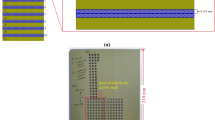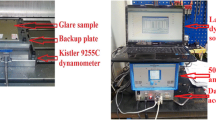Abstract
Drilling operations in fibre metal laminates (FML) require a considerable optimization activity of the machining parameters as a function of those used in drilling of its constituents, fibre reinforced polymers and aluminium alloy. The accurate choice of drilling parameters is essential to minimize any defects of machined surface and inside the material that may compromise the structural integrity of part: these aspects become more critical in dry machining used in aeronautic field. Several authors have studied FML drilling, but they focused their attention mostly on the cutting forces, torque, drill wear, surface quality and hole damage. Instead, very little literature exists about temperature field that develops during FML drilling and in particular, no numerical models have been developed to predict this issue. The aim of this work is to monitor the cutting force and temperature measured on the tool and workpiece during dry drilling of Al/GFRP hybrid laminates (GLARE). In particular, the trend of the thrust force and temperature according to the main process parameters has been analysed. In addition, a first numerical model for analysing the process temperature trend during drilling has been developed.

















Similar content being viewed by others
References
Sinmazçelik T, Avcu E, Bora MÖ, Çoban O (2011) A review: fibre metal laminates, background, bonding types and applied test methods. Mater Des 32:3671–3685
Sadighi M, Alderliesten RC, Benedictus R (2012) Impact resistance of fiber-metal laminates: a review. Int J Impact Eng 49:77–90
Chai GB, Manikandan P (2014) Low velocity impact response of fibre-metal laminates - a review. Compos Struct 107:363–381
Wu G, Yang JM (2005) The mechanical behavior of GLARE laminates for aircraft structures. J Miner Metals Mater Soc 57:72–79
Hoo Fatt MS, Lin C, Revilock DM Jr, Hopkins DA (2003) Ballistic impact of GLARE™ fiber-metal laminates. Compos Struct 61:73–88
Morinière FD, Alderliesten RC, Sadighi M, Benedictus R (2013) An integrated study on the low-velocity impact response of the GLARE fibre-metal laminate. Compos Struct 100:89–103
Kakati S, Chakraborty D (2020) Delamination in GLARE laminates under low velocity impact. Compos Struct 240:112083
Liu C, Du D, Li H, Hu Y, Xu Y, Tian J, Tao G, Tao J (2016) Interlaminar failure behavior of GLARE laminates under short-beam three-point-bending load. Compos B 97:361–367
Li H, Xu Y, Hua X, Liu C, Tao J (2018) Bending failure mechanism and flexural properties of GLARE laminates with different stacking sequences. Compos Struct 187:354–363
Zhong Y, Joshi SC (2015) Response of hygrothermally aged GLARE 4A laminates under static and cyclic loadings. Mater Des 87:138–148
Abrao AM, Faria PE, Campos Rubio JC, Reis P, Davim JP (2007) Drilling of fiber reinforced plastics: a review. J Mater Process Technol 186:1–7
Liu DF, Tang YJ, Cong WL (2012) A review of mechanical drilling for composite laminates. Compos Struct 94:1265–1279
Esposito L, Sorrentino L, Penta F, Bellini C (2016) Effect of curing overheating on interlaminar shear strength and its modelling in thick FRP laminates. Int J Adv Manuf Technol 87:2213–2220
Liu D, Tang Y, Cong WL (2012) A review of mechanical drilling for composite laminates. Compos Struct 94:1265–1279
John KM (2019) S Thirumalai Kumaran, Rendi Kurniawan, Ki Moon Park and JH Byeon, Review on the methodologies adopted to minimize the material damages in drilling of carbon fiber reinforced plastic composites. J Reinf Plast Compos 38(8):351–368
Genga D, Liu Y, Shao Z, Zhenghui Lu, Caia J, Li X, Jiang X, Zhang D (2019) Delamination formation, evaluation and suppression during drilling of composite laminates: a review. Compos Struct 216:168–186
Tsao CC, Kuo KL, Hsu IC (2012) Evaluation of a novel approach to a delamination factor after drilling composite laminates using a core–saw drill. Int J Adv Manuf Technol 59:617–622
Sorrentino L, Turchetta S, Bellini C (2018) A new method to reduce delaminations during drilling of frp laminates by feed rate control. Composite Structures, Ed Elsevier 186:154–164
Langella A, Nele L, Maio A (2005) A torque and thrust prediction model for drilling of composite materials. Compos Part A Appl Sci Manuf 36:83–93
Krishnaraj V, Prabukarthi A, Ramanathan A, Elanghovan N, Kumar MS, Zitoune R, Davim JP (2012) Optimization of machining parameters at high speed drilling of carbon fiber reinforced plastic (CFRP) laminates. Compos Part B 43:1791–1799
Le Coz G, Marinescu M, Devillez A, Dudzinski D, Velnom L (2012) Measuring temperature of rotating cutting tools: application to MQL drilling and dry milling of aerospace alloys. Appl Therm Eng 36:434–441
Zitoune R, Cadorin N, Collombet F, Šíma M (2017) Temperature and wear analysis in function of the cutting tool coating when drilling of composite structure: in situ measurement by optical fiber. Wear 376:1849–1858
Sorrentino L, Turchetta S, Bellini C (2017) In process monitoring of cutting temperature during the drilling of FRP laminate. Compos Struct 168:549–561
Zitoune R, Krishnaraj V, Collombet F (2010) Study of drilling of composite material and aluminium stack. Compos Struct 92:1246–1255
Wang CY, Chen Y, An QL, Cai XJ, Ming WW, Chen M (2015) Drilling temperature and hole quality in drilling of CFRP/aluminum stacks using diamond coated drill. Int J Precis Eng Manuf 16:1689–1697
Wang X, Kwon PY, Sturtevant C, Kim D, Lantrip J (2014) Comparative tool wear study based on drilling experiments on CFRP/Ti stack and its individual layers. Wear 317:265–276
Xu J, El Mansori M (2016) Experimental studies on the cutting characteristics of hybrid CFRP/Ti stacks. Procedia Manuf 5:270–281
Xu J, Mkaddem A, El Mansori M (2016) Recent advances in drilling hybrid FRP/Ti composite: a state-of-the-art review. Compos Struct 135:316–338
Xu J, Li C, Chen M, El Mansori M, Davim JP (2020) On the analysis of temperatures, surface morphologies and tool wear in drilling CFRP/Ti6Al4V stacks under different cutting sequence strategies. Compos Struct 234:111708
Sato M, Tanaka H, Yamamoto K (2016) Temperature variations in drilling of CFRP/aluminum and CFRP/titanium stacks. Int J Autom Technol 10(3):348–355
Montoya M, Calamaz M, Gehin D, Girot F (2013) Evaluation of the performance of coated and uncoated carbide tools in drilling thick CFRP/aluminium alloy stacks. Int J Adv Manuf Technol 68:2111–2120
Bonhin EP, David-Muzel S, de Sampaio Alves MC, Botelho EC, Ribeiro MV (2021) A review of mechanical drilling on fiber metal laminates. Int J Adv Manuf Technol 55:6
Tyczynski P, Lemanczyk J, Ostrowski R (2014) Drilling of CFRP, GFRP, glare type composites. Aircr Eng Aerosp Technol 86:312–322
Brinksmeier E (2014) Machinability of carbon-fiber-reinforced and glare materials. CIRP Encycl Prod Eng
Giasin K, Hawxwell J, Sinke J, Dhakal H, Köklü U, Brousseau E (2020) The effect of cutting tool coating on the form and dimensional errors of machined holes in GLARE® fibre metal laminates. Int J Adv Manuf Technol 107:2817–2832
Park SY, Choi WJ, Choi CH, Choi HS (2018) Effect of drilling parameters on hole quality and delamination of hybrid GLARE laminate. Compos Struct 185:684–698
Pawar OA, Gaikhe YS, Tewari A, Sundaram R, Joshi SS (2015) Analysis of hole quality in drilling glare fiber metal laminates. Compos Struct 123:350–365
Boughdiri I, Giasin K, Mabrouki T, Zitoune R (2021) Effect of cutting parameters on thrust force, torque, hole quality and dust generation during drilling of GLARE 2B laminates. Compos Struct 261:113562
Giasin K, Ayvar-Soberanis S (2017) An Investigation of burrs, chip formation, hole size, circularity and delamination during drilling operation of GLARE using ANOVA. Compos Struct 159:745–760
Giasin K, Ayvar-Soberanis S, Hodzic A (2016) Evaluation of cryogenic cooling and minimum quantity lubrication effects on machining glare laminates using design of experiments. J Clean Prod 135:533–548
Giasin K, Ayvar-Soberanis S (2016) Evaluation of workpiece temperature during drilling of GLARE fiber metal laminates using infrared techniques: effect of cutting parameters, fiber orientation and spray mist application. Materials 9(8):622
Giasin K (2018) The effect of drilling parameters, cooling technology, and fiber orientation on hole perpendicularity error in fiber metal laminates. Int J Adv Manuf Technol 97:4081–4099
Giasin K, Ayvar-Soberanis S, French T, Phadnis V (2017) 3d finite element modelling of cutting forces in drilling fibre metal laminates and experimental hole quality analysis. Appl Compos Mater 24:113–137
Funding
This work was carried out with the funding of the Italian M.U.R. (Ministry of University and Technological Research). Special thanks to Martina e Lorenzo S.
Author information
Authors and Affiliations
Contributions
All authors have participated in (a) design, analysis and interpretation of the data; (b) drafting the article critically; and (c) approval of the final version.
Corresponding author
Ethics declarations
Ethics approval
All used materials and applied devices included in the manuscript belong to the authors and do not require any third party permission. This manuscript has not been submitted to another journal.
Consent to participate
The mentioned authors participated in all steps of the manuscript preparation.
Consent for publication
All authors have read and agreed to publish the manuscript if accepted.
Competing interests
The authors declare no competing interests.
Additional information
Publisher's Note
Springer Nature remains neutral with regard to jurisdictional claims in published maps and institutional affiliations.
Rights and permissions
About this article
Cite this article
Sorrentino, L., Turchetta, S. & Parodo, G. Drilling of glare laminates: effect of cutting parameters on process forces and temperatures. Int J Adv Manuf Technol 120, 645–657 (2022). https://doi.org/10.1007/s00170-021-08612-z
Received:
Accepted:
Published:
Issue Date:
DOI: https://doi.org/10.1007/s00170-021-08612-z




